Text
The Architects of Islam: Mimar Sinan
Architecture created in the Islamic style was brought to fruition not on its own, but by some of the most outstanding architects to date (in my opinion).
In accordance to this blog, this following post will be dedicated three architects that paved the way to the present ideas and characteristics of Islamic architecture displayed across the world.
To begin this blog, I'll start with Mimar Sinan - who is arguably the most famous architect to build in the Islamic style.
(I apologise for spelling mistakes when it comes to the names of people and locations, through research, there have been several spellings of the same things, and so I used the most common spelling. Please correct me if it is wrong! This applies to all previous and future blog posts.)
Mimar Sinan
Mimar Sinan (1488/1490-1588) was the son of a Greek or Armenian convert to Islam, Abd al-Mannan. He joined the elite corps of the Ottoman army, the janissaries as a young man, like his father before him. During this time of Sinan's life, his talent as an engineer became known - he rose through the ranks in the military becoming an officer in the army who participated in several military campaigns under sultans Selim and Suleiman. As the Ottoman armies marched to new extents in Europe, Africa, and Persia - Sinan accompanied them and organised the engineering corps for the military as well as building mosques and other civil buildings in newly Ottoman cities. In 1539, Sinan was given the position of head architect of the sultan's government in Istanbul (Archive: Islam., 2023).
Mimar Sinan's career saw him undertake a number of projects; 79 mosques, 34 palaces, 33 public baths, 19 tombs, 55 schools, 16 poorhouses, 7 madrasahs, and 12 caravansaries - with the Şehzade Mosque, the Mosque of Süleiman I the Magnificent and the Selim Mosque being his most famous works (the latter was discussed in the previous blog post) - with all three residing in Turkey (Britannica., 1998).
The Ottoman mosques were largely inspired by the architecture of the Hagia Sophia in Istanbul, Turkey (537 AD). Originally built as a Christian church in 537 by the Byzantines, the Hagia Sophia was converted to a mosque to to serve the new Muslim population after Mehmed II's conquest of the city in 1453 - and ever since, Ottoman architects such as Mimar Sinan used the Hagia Sophia's giant dome as a template for the design of Muslim mosques. Due to the grandness in scale and design of the Hagia Sophia, many architects made it their career mission to design something to top the it - including Mimar Sinan as he made it his goal to build a monument to Islam that was more magnificent than the Hagia Sophia.
This led to the one of the inspirations behind the construction of the Suleymaniye Mosque in Istanbul, Turkey. In 1543, one of the Sultan Suleiman's sons, Prince Mehmed, died of smallpox - and in turn Suleyman insisted on building a large mosque in his honour that would serve the local community. Mimar Sinan was tasked with this project, and over four years he worked on what would transition into what is now known as the Şehzade Camii (the Prince's Mosque).

The Sehzade Mosque
Upon completion, the mosque became a landmark of the city, and included not only a mosque but a complex that included a soup kitchen for the poor, a place for travellers to sleep, and a tomb for Prince Mehmed. Sultan Suleiman was extremely pleased with it but Sinan was not satisfied - and insisted he would do better - which leads us back to the inspiration behind the Suleymaniye Mosque.
Sultan Suleiman wanted another giant mosque in Istanbul, with this one being named after himself so he can accumulate the good deeds of Muslims who pray in it after he dies. He wanted it to be a central part of Istanbul's skyline to show the supremacy and glory of Islam (Archive Islam., 2023), this led to the decision of placing the mosque on top of a hill near the Golden Horn - meaning it could be seen for miles around.
There is a rumour that once the foundation was laid, Mimar Sinan went missing for five years! Suleiman was furious with the missing Sinan, and demanded to know where his favourite architect had gone, once the five years had passed, Sinan returned with the explanation that because the building would be so massive, he needed to let the foundations to settle in the soil before above ground building could commence.
The Suleymaniye Mosque was completed in 1557, and the reveal of what is now one of the most significant pieces of Islamic architecture not only to Mimar Sinan's career, but to the architectural world as a whole. Like the Sehzade Mosque, the building did not only serve as a place of worship, but also a kulliye (complex) which held a hospital, public baths, a library - which is still used today - a soup kitchen, numerous schools teaching Quran, a school for Hadith, and a primary school for children. The cemetery in which Sultan Suleiman is buried is also in this location.
Like other mosques in Istanbul, the entrance to the mosque holds a forecourt and a central fountain, and the exterior of the building is decorated with rectangular blue coloured Iznik tile window lunettes. To the south of the mosque is where the madrassa housing a library containing 110,000 manuscripts. There are minarets at all four of the corners of the courtyard, half short and half tall, which is a sign that the mosque was endowed by a sultan, as princes and princesses could only construct two minarets and others could only construct one minaret. Unfortunately, in 1660 the mosque was ravaged by a fire and then restored by Sultan Mehmed IV, then in 1766 part of the dome collapsed during an earthquake, and due to repairs, what was left of the original decoration by Sinan was damaged (Islamic Landmarks., 2023).
And yet, even after Sinan created this masterpiece, which was received incredibly, he still believed he could do much better.
This then transitioned into the commissioning of the Selimiye Mosque in Edirne, which rivalled Hagia Sophia after Suleiman died in 1566. This left his son and successor Selim II in charge and wanting a mosque built in his name, despite being much older when construction began for the Selimiye Mosque, Sinan was determined to make his masterpiece.
The architecture for his masterpiece was discussed in depth in the previous blog.

The Selimiye Mosque
Mimar Sinan died in 1588 at age 98 or 100 (his birth year is unknown) and was buried in the cemetery of the Suleymaniye mosque, near Sultan Suleiman. During life, Sinan built some of the greatest examples of Islamic architecture ever - and is as of 2023, one of the most successful and acclaimed Muslim architects to grace the planet - and the impact on the Muslim world being not limited to just mosques supports his reputation. His apprentices went on to build other major landmarks such as The Blue Mosque (discussed in the previous blog) and notably the Taj Mahal in Agra, India.
His works remain some of the greatest symbols of Islam, centuries after his death and impressive career.
Thank you for reading the first half of this blog - the following blog will discuss my second chosen architect.
Thank you for reading, and hopefully you enjoyed! Please like and share if you did!
Summer Marshall-Miller
Bibliography:
Archive: Islam (2023) The Greatest Architect was a Muslim. Available at:
https://archiveislam.com/the-greatest-architect-was-a-muslim.html (Accessed: March 1, 2023).
Britannica (1998) Sinan. Available at: https://www.britannica.com/biography/Sinan (Accessed: March 1, 2023).
Islamic Landmarks (2023) Süleymaniye Mosque. Available at: https://www.islamiclandmarks.com/turkey/suleymaniye-mosque (Accessed: March 1 2023).
9 notes
·
View notes
Text
Religion in Islamic Architecture
Even though there are some parts of Islamic architecture that to modern knowledge lack symbolic religious significance, there are, nevertheless, connections to religion. Islam, which believes that everything and anything created by God is under his order and should not be idolised, does not sensationalise living things, in contract to Christianity.
The monotheistic religion of Islam has its own tenets and traditions, such as charity, fasting during Ramadan, and if possible, a pilgrimage to Mecca - even though it shares the prophetic history of Judaism and Christianity. Although it can he challenging to define Islamic art, it is understood that not all Islamic art is religious and that not all artists who produce said art must be Muslims (Artsy Net., 2023).
With regards to architecture, as mentioned, there can often be no symbolic links to religion, and the connections that are made, are often portrayed through the use of calligraphy, colour and geometry - the hallmark characteristics of Islamic architecture.
This specific blog post will explore the architecture of some of the most outstanding examples of religious institutions within Islamic style architecture - beginning with The Blue Mosque in Istanbul.
Sultanahmet Mosque (The Blue Mosque)

The Blue Mosque, Istanbul, 1723.
The Sultanahmet Mosque (Sultanahmet Camii) more commonly known as The Blue Mosque was constructed between 1609 and 1616 during the rule of Ahmed I by architect Sedefkâr Mehmed Agha - the detailed workbook of the construction of this mosque consists of eight volumes and still lies in the Topkapi Palace library. The recognised name of 'The Blue Mosque' being attached to the building is due to the hand-painted blue tiles that adorn the interior walls, alongside the blue cast that envelopes the mosque of a night time as a result of lights framing the mosque's five main domes, six minarets and eight secondary domes.
The Blue Mosque features two main sections: a large unified prayer hall crowned by the main dome and an equally spacious courtyard (Smart History., 2023). As mentioned, the Mosque has six minarets (the only other mosque in the world with this many minarets was the Haram Mosque of Mecca - this led to the religious leaders of the time to become outraged and send out the Sultan's architect to Mecca to build a seventh minaret so that the holiest of mosques could retain 'superior status') and eight secondary domes, and its design was a culmination of two centuries of Ottoman Mosque design, with an incorporation of Byzantine elements of the neighbouring architectural masterpiece Hagia Sophia with traditional Islamic architecture and is considered to be the last great mosque of the classical period. Sedefkâr Mehmed Agha, the architect, synthesised the ideas of his master Sinan, aiming for overwhelming size, majesty and splendour (Architectuul., 2023).
Tall wooden gates envelop the courtyard of the mosque, and the mosque itself is revealed behind the gates presenting spectacular dove-grey domes, marble walls and gold-tipped minarets. Tourists are recommended to use the south door of the Mosque as to allow worshippers to enter through the main door only, and allows for the prayer sections of the Mosque to retain its sacred air.
Upon entrance of the mosque, there is an introduction to the more than 20,000 blue Iznik tiles in traditional Ottoman patterns adorn the walls and ceilings. Lilies, carnations and tulips are depicted throughout. The Blue Mosque's interior domes are tiled intricately, painted and decorated with verses from the Quran and the sayings of prophet Muhammed (The Travel Bunny., 2021). Many of them written by Seyyid Karim Gubari, a 17th century Ottoman artist celebrated as one of the most accomplished calligraphers of his time.
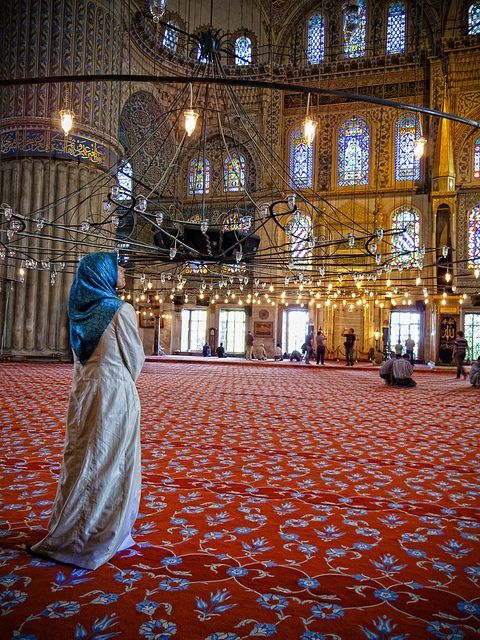
The upper levels of the building have more than 200 stained glassed windows - the coloured glass for the windows were a gift from the Signoria of Venice to the Sultan - with beautiful designs allowing natural light to ascend the interior, as of modern day there are chandeliers to aid the lighting in the building. On the chandeliers, ostrich eggs are found that were meant to avoid cobwebs inside the mosque by repelling spiders.
The floors wear carpets that are regularly replaced by donations due to them getting worn out because of the number of visitors that walk upon it.
According to architectuul.com, the most important element of the interior of the mosque is the mihrab, which is finely carved and sculptured marble, with a stalactite niche and a double inscriptive panel above it. Surrounded by many windows - the adjacent walls are sheathed in ceramic tiles.
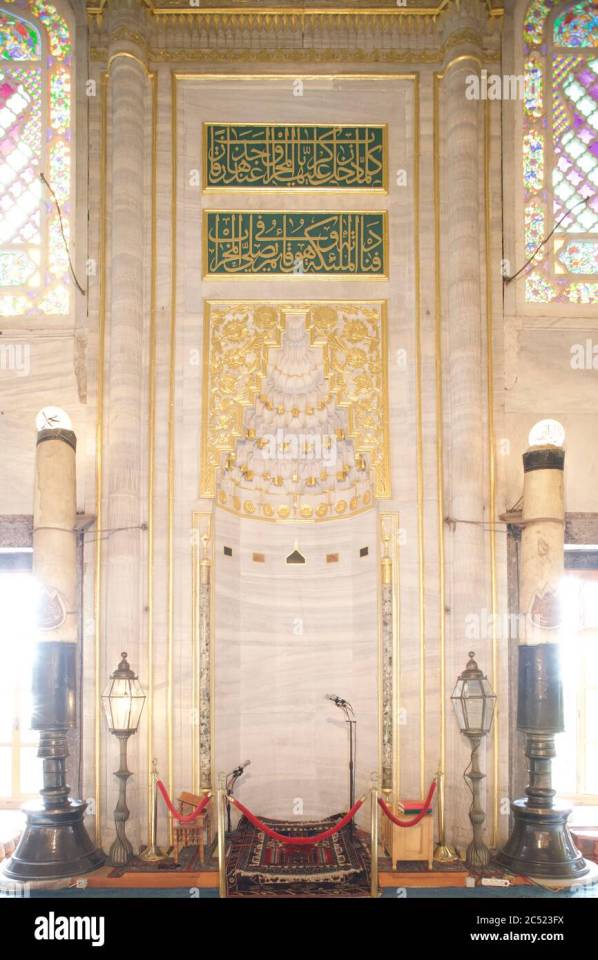
Mihrab of Sultanahmet. The Blue Mosque.
Architecturally, the best way to enter The Blue Mosque is to approach it from the hippodrome (west side of the mosque) - non-muslim tourists are encouraged to visit the mosque, however, they are not allowed in during prayer time, which is of course five times a day - the mosque closes for 90 minuted each time. Shoes have to be removed from your person, and it is vital that you are dressed appropriately, women should wear a head covering - but they are freely available upon entrance of the establishment. For everyone, legs and shoulders should be covered.
It is absolutely required that tourists do not use flash photography and remain quiet always - this is not just an architectural masterpiece, but a place of worship, and that should be respected always.
Selimiye Mosque
The second religious institution to be analysed on Building Islam is another Turkish mosque called Selimiye Mosque in Edirne, and started construction in 1568 with its completion in 1574 by architect Mimar Sinan - a famous architect of the time who will be explored in the upcoming blog post.
The Selimiye Mosque was built at the peak of the Ottoman military and cultural power, Sultan Selim II - the son and successor of Suleiman the Magnificent, chose Edirne instead of Istanbul as the location to build his own sultan mosque. It is debated amongst historians as to why this location was chosen with some speculating Selim II had a passion for the city as he serves as governer between 1548 and 1550, and others speculating it is because Selim II had not commanded a victorious military campaign which Islamic scholars believe to have been a requirement for building a sultanic mosque in Istanbul. The construction of this mosque was funded by the help of the sultan's share of the spoils from the successful conquest of Cyprus, Selim II died in December 1574 meaning he never saw the mosque fully completed (UNESCO., 2023).
The Selimiye Mosque is considered to be the masterpiece of architect Sinan's entire career, and is thought to be one of the most important buildings in the history of the world - architecturally and monumentality. The mosque, together with the two madrasas on its southeast and southwest is located within a courtyard. A row of shops and recitation school (darülkurra) to the west of the courtyard were added to the complex by architect Davud Aga in the reign of the Sultan Murad III (1574-95).
The mosque has a rectangular, borderline square, prayer hall and on the north side, a courtyard with porticoes. There are three entrances to the courtyard, north, east and west. In the centre of the courtyard is a 12-sided fountain. Each corner of the prayer hall features a 71m high minaret each with a balcony. The mentioned balconies are accessed by three separate corners on the northeast and northwest corners (Discover Islamic Art., 2023). The approach to the north façade of the mosque is dramatic with aligned gates of the outer precinct wall and forecourt focus the eye upwards towards the intricately designed dome.

The dome rests on eight muqarnas-corbelled squinches that are in turn supported by eight large piers.
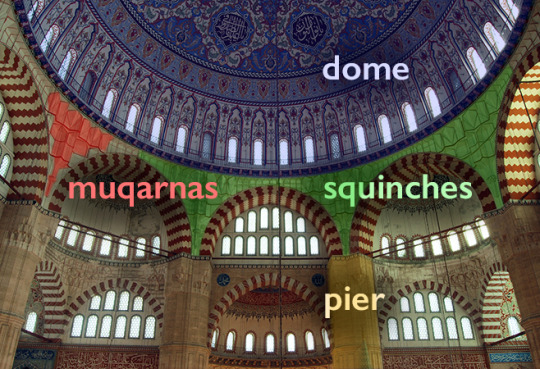
Muqarnas are faceted decorative forms used in Islamic architecture to bridge a point of transition - in relation to the Selimiye Mosque, the broad base of the dome above and the slender piers below (Khan Academy., 2023). A complex system of exterior buttresses support the east and west piers and do most of the handling for the weight of the dome. The buttresses are purposely hidden amongst the exterior porticos and galleries. The interior allows for galleries to fill the spaces in between the walls and the piers. The Qibla wall (the wall facing Mecca) projects outwards to emphasise the vast interior space. Another unusual thing that was decided upon through construction by architect Sinan, was the placement of the muezzins platform - under the centre of the dome. From the platform, the muezzins who lead prayer chant to congregation, and art historians have compared its positioning within the mosque to that of a church altar - a raised stand for biblical readings - supporting the fact that Sinan was interested in surpassing Christian architecture. The platform also creates a vertical alignment of square, octagon and circle, using geometry to refer to earthly and heavenly spaces.
Through the centuries since the construction of the Selimiye Mosque, the interior had changed as it has been repainted and then extensively restored in the 20th century. The polychrome Iznik tiles remain largely untouched since the 16th century, but in the 19th century Sultan Abdülmecid I had most of the painted decoration including arabesque motifs, plant of flower motifs, and calligraphic inscriptions added for his ordered restoration.
The sultan's private balcony for prayers, is set to the eastern corner of the mosque in an elevated position and is intricately decorated with Iznik tiles also.

Iznik tiles next to the mihrab.
The Selimiye Mosque was not only an architectural masterpiece in relation to Mimar Sinan's incredible career but in regards to the influence it had on later mosque constructions. The form of Laleli Mosque in Istanbul built in the 18th century is based on the Selimiye Mosque, as well as the modern Sabancı Merkez Camii in Adana (1988). Despite being 80% the size of the Selimiye Mosque, the Nizamiye Mosque in South Africa is modelled on it and remains the largest in the Southern hemisphere.

Laleli Mosque, Istanbul Turkey.

Sabancı Merkez Camii, Istanbul Turkey.

Nizamiye Mosque, South Africa.
Having now discussed two architectural pieces of religious institutions in the Islamic architectural style, the following blog post will focus on the work of three of the most celebrated Islamic architects and their works containing Mosques.
The production of this blog took much longer than anticipated but to finalise this post, I will share that in the next couple of posts I will be incorporating images of my own families homes and local mosques in Pakistan - the incorporation of my personal family and life has come about thanks to a group of fellow students named The Blog Club that help me with deciding what to talk about next! And hopefully create an informal, comfortable space for everyone to discuss their thoughts and opinions!
P.S. The Blue Mosque and The Selimiye Mosque are some of my favourite examples of Islamic architecture!
Summer Marshall-Miller
BIBLIOGRAPHY:
THE BLUE MOSQUE
Artsy Net (2023) Islamic Art and Architecture. Available at: https://www.artsy.net/gene/islamic-art-and-architecture (Accessed: February 15, 2023).
Smart History (2023) The Blue Mosque (Sultan Ahmet Camii). Available at: https://smarthistory.org/the-blue-mosque-sultan-ahmet-camii/ (Accessed: February 15, 2023).
Architectuul (2023) Blue Mosque. Available at: https://architectuul.com/architecture/blue-mosque (Accessed: February 15, 2023).
The Travel Money (2021) Istanbul and the Beauty of the Blue Mosque. Available at: https://thetravelbunny.com/istanbul-blue-mosque/ (Accessed: February 15, 2023).
Blue Mosque (2023) Blue Mosque Mosque in Turkey. Available at: https://bluemosque.co/en/ (Accessed: February 15, 2023).
THE SELIMIYE MOSQUE
UNESCO (2023) Selimiye Mosque and its Social Complex. Available at: https://whc.unesco.org/en/list/1366/ (Accessed: February 20, 2023).
Discover Islamic Art (2023) Selimiye Mosque. Available at: https://islamicart.museumwnf.org/database_item.php?id=monument;isl;tr;mon01;23;en (Accessed: February 20, 2023).
11 notes
·
View notes
Text
What is Islamic Architecture?
Islamic Architecture is an architectural style that dominates Muslim-majority countries around the world such as Indonesia, Pakistan, Egypt, Saudi Arabia, Turkey and many more, but is not limited to these locations. Islamic architecture can be found across the globe - though the architecture in other locations may not hold all the main characteristics - there are definite elements that have been incorporated into the western, modern world, (The Spruce., 2022).
This architectural style is associated with the religion of Islam, and has evolved from various other architectural styles like that of Mesopotamian and Roman.
Islamic architecture has several characteristics that are recognisable to even the untrained eye; the use of colour, geometric shapes, symmetry, patterns and calligraphy define the architectural style (Invaluable., 2020). This style of architecture is typically associated with religious establishments in Islam such as the Mosque, but is not restricted to this, the style extends to palaces, tombs, forts and public buildings. One of the oldest elements to identifying Islamic architecture is the presence of Minarets and domes. Minarets are tower-like structures with small windows and enclosed spiral staircases made for muezzins (a man who calls Muslims to pray) to call to worshippers from a high point. The minarets often feature one or more balconies. The forms of the minarets commonly seen range from thick, squat, spiral ramps to soaring, delicate, pencil-thin spires, with the base usually being square in shape. The number of minarets located in a Mosque will vary from one to six and they stand as landmarks of Islam.
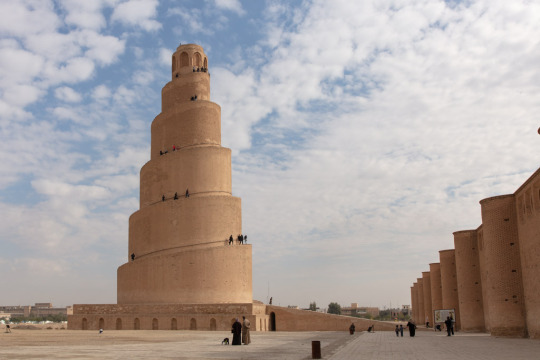
Grand Mosque of Samarra and the spiralling Malwiya Minaret (Adventures of Nicole., 2022).
Domes (like several other architectural movements such as Renaissance and Byzantine) are also a regular feature of islamic architecture.
The first Islamic design featuring a dome is a 7th century shrine in Jerusalem - Dome of the Rock, Arabic Qubbat al-Ṣakhrah. Dome of the Rock was built by Umayyad caliph (chief Muslim civil and religious ruler of the first Muslim dynasty) 'Abd al-Malik ibn Marwān. The structure is situated on a flat elevated plaza known to Muslims as 'The Noble Sanctuary' (al-Haram al-Sharīf), and the rock above which the dome is located is the spot the propet Muhammad was taken up into heaven for an encounter with God (Mi'rāj), (Britannica., 2014).
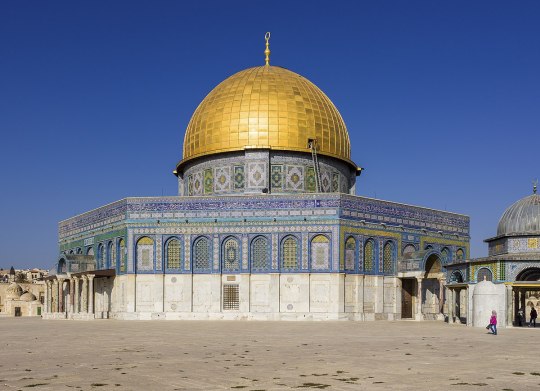
Dome of the Rock, Jerusalem, 691-692 CE.
Most domes rest on pendentives which are constructional devices used to place circular domes over square or rectangular shaped rooms. You can recognise pendentives as Islamic architecture by its decorative tiles or muqarnas - a form of ornamental vaulting, (IvyPanda.,2020).

Diagram of pendentives.

Muqarnas and decorative tiles example.
The most important piece of indo-Islamic architecture os the tomb of the Shah Rukn-i-Alam in Multan. This tomb was built between 1320 and 1324 CE by Giyath al-Din Tughluq in the pre-mughal, architectural style, Giyath was the governor of Diplapor (a city in the Okara District of the Punjab, Pakistan) and is thought to have been built to serve as a tomb for himself. However, it was presented to the family of the renowned Sufi saint Sheikh Rukn-ud-Din Abul Fateh (Sacred Sites., 2020). The tomb is an octagonal shape, 35m high and structured by red brick with a visible frame of beams and shisam wood, and further designed with the use of carved brick, wood blue and white faience mosaic tiles with raised relief patterns. The octagon is decorated with geometric, floral, and arabesque designs and calligraphic motifs. The interior was originally plastered but is now bare and the sarcophagus is surrounded by 72 of his descendants. The saint is still held in high esteem and the tomb is the focus of over 100,000 pilgrims from all over South Asia who visit in order to commemorate his memory, (Unesco., 2004).
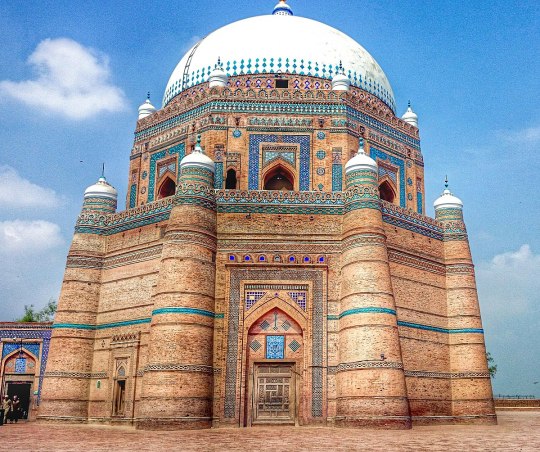
Shah Rukn-i-Alam, Multan, Pakistan.
Arches are yet another prominent feature of identifying Islamic architecture, and their placements usually define the entrances to buildings and rooms. There are several types of arches including: Pointed Arches, Ogee Arches, Horseshoe Arches, and Multifoil Arches. The double arched system of the Mosque-Cathedral of Córdoba, the pointed arches of the Al-Aqsa masque provide excellent examples of how arches become indispensable features of Islamic architecture (Rethinking the Future., 2023).

Double Arches of Mosque-Cathedral of Córdoba
The majority of mosques and palaces falling under the style of Islamic architecture feature courtyards and can house large gatherings of people during festive occasions and prayers. The courtyards will feature fountains for the people to perform ablution before prayers.
Now that there has been an introduction into what it takes to create for Islamic styled architecture, the rest of the blog is open to deeper dives of certain establishments, countries, and architects themselves,
Thank you for reading, I hope you enjoyed!
Summer Marshall-Miller
BIBLIOGRAPHY: Hohenadel, K. (2022) The Spruce. Available at: https://www.thespruce.com/what-is-islamic-architecture-5120474 (Accessed 20 January, 2023)
Britannica, The Editors of Encyclopaedia. (2014) Encyclopaedia Britannica. Available at: https://www.britannica.com/topic/mosque (Accessed: 20 January, 2023)
Unknown Author (2020) Invaluable. Available at: https://www.invaluable.com/blog/islamic-art-patterns/ (Accessed: 21 January, 2023)
IvyPanda (2020) 'Muqarnas in Islamic Architecture'. Available at: https://ivypanda.com/essays/muqarnas-in-islamic-architecture/ (Accessed: 24 January 2023)
UNESCO (2004) Tomb of Shah Rukn-e-Alam. Available at:https://whc.unesco.org/en/tentativelists/1884/#:~:text=The%20tomb%20of%20Shah%20Rukn,saint%20following%20the%20latter%27s%20death (Accessed 7th December 2022).
Unknown Author (2023) Rethinking the Future. Available at: https://www.re-thinkingthefuture.com/architectural-styles/a2589-10-distinctive-elements-of-islamic-architecture/ (Accessed: 23 January 2023).
Nicole Smoot (2022) The Adventures of Nicole. Available at: https://adventuresoflilnicki.com/samarra-iraq/ (Accessed: 23 January 2023).
#architecture#islamicarchitecture#art#history of art#islamic#mosque#history#my blogs#student#major project
33 notes
·
View notes
Text
Introducing Building Islam!
Hi all and welcome to Building Islam!
My name is Summer and this blog is in direct conjunction with my final year major project at Liverpool John Moores University. This blog aims to serve as a resource for all things Islamic architecture, from the introduction of it around the 7th century, to its modern transition into the Western world. Questions and queries are happily accepted in the form of private messages or simple comments! With each and every blog post, there will be a conscious effort to improve the following based on a group of fellow History of Art students that will gather every week to review my research and work. They will provide feedback and advice for the future posts and help improve my standards of not only research but writing, too. There will be 1-2 blog entries produced every week shedding light and sharing information and opinions on some of the most impressive architectural structures, and architects to date (in my opinion). All interactions with this blog will be highly appreciated and monitored for tracking purposes and hopefully this blog serves as a resource for like minded curious people! A bibliography will be provided at the end of every post to give access to further information and resources for the curious reader!
Thank you for your time and I hope you enjoy!
Summer Marshall-Miller
#architecture#introduction#islamic#islamicarchitecture#informative#research#student#university#liverpooljohnmooresuniversity#history#history of art
14 notes
·
View notes